Build a Business Website in 2024: Domains, Templates & More
If you click to purchase a product or service based on our independent recommendations and impartial reviews, we may receive a commission. Learn more
So you want to build a website for your business? Before you start imagining scenarios of late nights grueling over coding or advanced web design, let me divert your attention to website builders. With this tool, you can set up a professional business website without any technical expertise.
If you’re not sure where to begin, I recommend a website builder like Wix or Shopify. Two of the top-rated builders for small businesses, these platforms come with an array of features that could be useful for your business website, from ecommerce to marketing.
Keen to begin? Keep reading and learn how to make a small business website today.
Before You Start Your Business Website…
Before you dive into creating a website for your business, you need to map out a few things first. Here are three questions to ask yourself:
- Why do you need to make a website for your business? First of all, you need to identify why you want to build a business website. Would you like to grow your presence online? Promote your services? Showcase your creative works to potential clients? Figuring out the key motivations behind your website will help you later on, since you’ll be able to identify key website features that’ll help you achieve your goals.
- Who is the target audience? After establishing why you’re building a business website, start thinking about who you want to visit your website. Identify your audience’s age range, gender, location, interests, and lifestyle first. From there, you can work out what their unique needs might be and how your business website can bring value to them.
- What will your branding look like? Your website’s looks are essential to its success. To stand out from the crowd, make sure your brand identity is eye-catching, memorable, and represents your business well. Logos, fonts, color schemes, and tone of voice are important aspects to cover. Altogether, they should accurately represent your brand’s personality and give website visitors a clear idea of what you stand for.
Need some ideas? Be inspired by these 7 brand identity examples.
1. Choose Your Domain Name
Your domain name is how people will find your business website online, so make it count. Since it’s one of the first things people see, ensure that it’s clear, catchy, and memorable (just like our own domain, “websitebuilderexpert.com”).
But how do you get a domain? Well, some website builders let you access a free domain for your first year. For instance, Wix’s paid plans include a free domain for 1 year, letting you choose from suffixes like “.com” or “.net”.
However, at renewal, you’ll need to pay an annual fee ranging from $20-$70 to keep your domain running. This gives you two options: you could either stick with your website builder and pay the annual fee, or switch to a domain name registrar for more choice.
Domain name registrars are great if you’re looking for flexible pricing options. I recommend Domain.com, since it has a large number of domain suffixes to choose from.
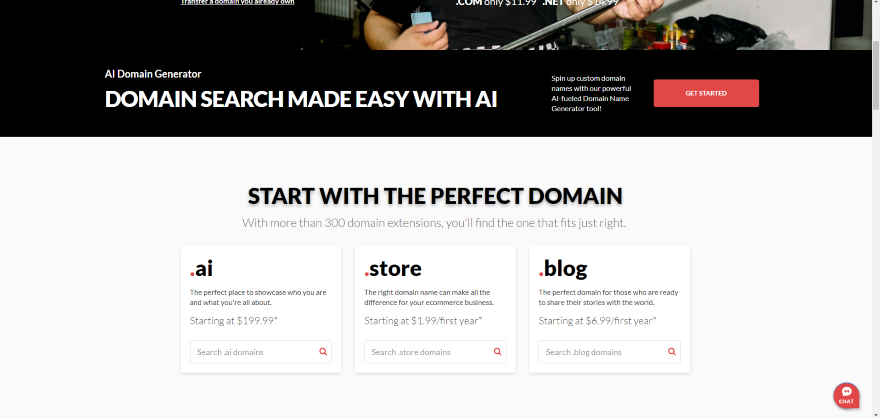
As a general rule of thumb, I suggest opting for a “.com” suffix if it’s available. This is because it’s the most recognisable and professional domain ending. If you think of one of the biggest brands in the world, it’s likely that their website ends with “.com”. If you’re using Domain.com, this suffix costs $11.99 for the first year and rises to $21.99 per year at renewal.
How Do I Come Up With a Good Domain Name?
Struggling to choose a domain name? Here are three key tips to help you out:
- Is it short? Effective domain names are between 6-14 characters long. Names that are too long are trickier for users to type down, making it difficult to access your website.
- Does it make sense? Your domain should have a logical connection to your website. For instance, “booking.com” tells you exactly what the website is for (holiday bookings).
- Are there unnecessary characters? Avoid using numbers or hyphens since this can make your domain look messy.
If you already have a business name, it’s best practice to make it your domain name too (if it’s available). This is so pre-existing customers who are already familiar with your brand can easily access your website. For instance, if your business name is “best domains”, you could easily convert that into “bestdomains.com” or “bestdomains.org.”
2. Create a Business Email Address
Though you don’t need a business email address to set up your website, it will help you establish a professional presence online and leave website visitors with an easy way to contact you. Conveniently, business emails are easy to create, with a number of free and paid options available.
For best results, I recommend Google Workspace. Though it’s no longer free to use, you can create your own professional email from as little as $6 per month (billed annually), while its 14-day free trial will help you try before you buy.
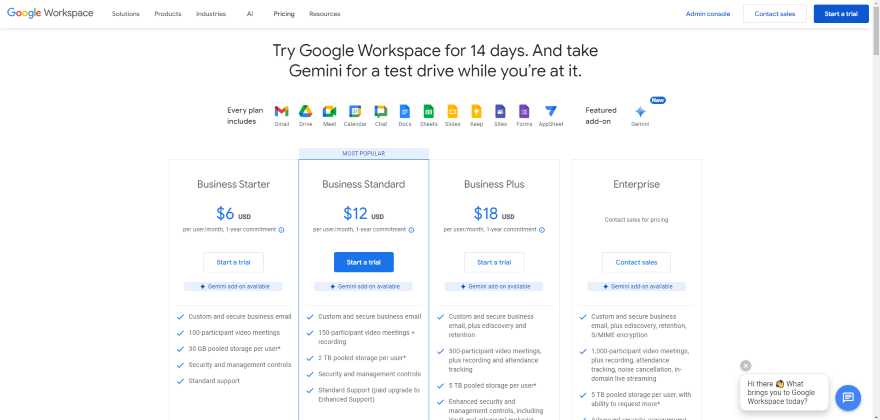
Want a professional email without spending a penny? Read our guide to getting a free business email.
What Does a Good Business Email Look Like?
The best business email addresses end with the name of your business. In fact, you can have multiple email addresses for different areas of your business, so long as they end the same way:
Each of these emails clearly indicate what they’re used for, also ending with the name of the business. I know that I could contact “[email protected]” to receive information on a specific query and that it’ll be sent to the correct company.
Make sure any business email addresses are easily discoverable from your website, newsletters, and social media pages. This is so customers know how to contact you!
3. Identify the Right Website Builder for You
Now for the serious part: choosing the right website builder for your business. Since there’s so much choice, I’ve decided to highlight only two website builders that we found were excellent solutions for small businesses during our research and testing. Both Wix and Shopify are powerful platforms that make it easy to set up without any technical experience.
The Best Small Business Website Builders
Shopify Summary
Our top-rated website builder for small businesses, Shopify is best for ecommerce stores that are scaling up or have a large inventory already. It comes with a host of powerful sales features, ranging from over 100 payment gateways to substantial discounts on merchant shipping costs.
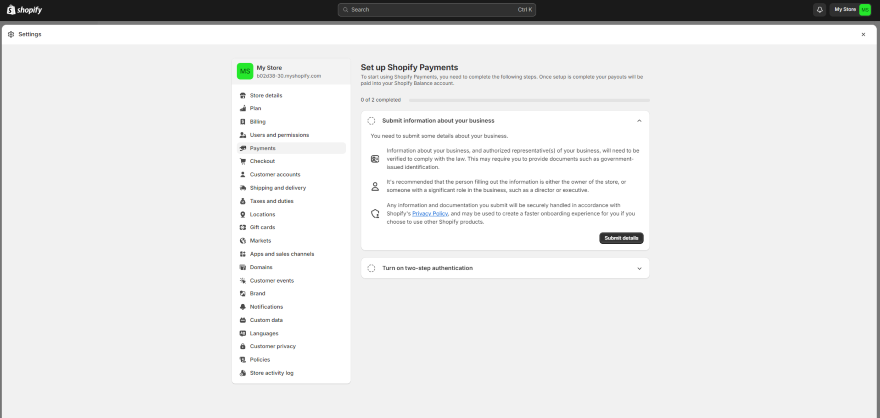
Whether you’re selling gym wear or pet accessories, Shopify’s huge list of sales features are adaptable to your needs. You can use Shopify Magic to generate product descriptions, or set up international shipping across different markets if you’re selling overseas.
Wix Summary
Just behind Shopify comes Wix, a popular website builder that we scored highly for its impressive website features that span bookings, ecommerce, and marketing. If you want a website builder that will provide you with the tools necessary to get set up and start growing your business online, this is the builder to go for.
Notable features include Wix’s AI tools, in particular, Wix ADI. This AI website builder generates a unique design based on your responses to specific prompts, such as “what are you building a website for?” Since it addresses your key needs, you’ll end up with a professional website that’s a suitable fit for your business.
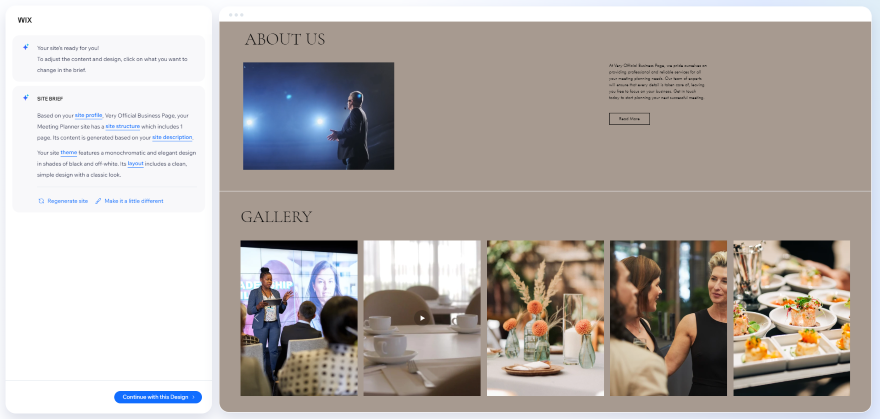
Which Pricing Plan Is Best for Me?
Once you’ve found a website builder you’re interested in, you need to look at the pricing plans available and see which one is best for you. To give you an idea of the kinds of plans on the market, we’ve broken down the costs for Shopify and Wix.
Shopify’s three main plans range between $29-$299 per month (billed annually). They all come with powerful sales features, such as point of sale to integrate in-person sales with your store, analytics to track your store’s progress with, and the ability to sell unlimited products.
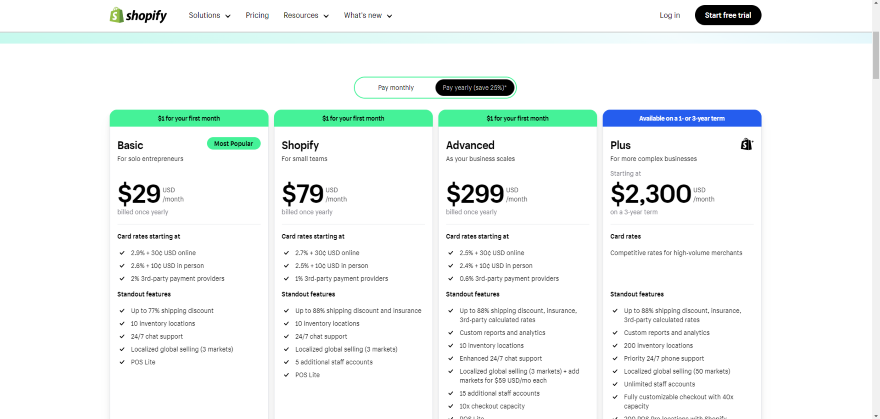
To test out Shopify’s features, you only have a 3-day free trial. However, you can also access your first month for $1 – an inexpensive way to give the platform a spin!
For smaller businesses, I recommend the Basic plan priced at $29 per month (billed annually). You’ll still receive powerful sales features, while it’s also a brilliant starting point for new businesses who anticipate growth further down the road. For instance, you’ll have access to 3 international markets, helping you dip your toes into selling overseas.
As your business expands, you could switch to the Shopify plan at $79 per month (billed annually). On this plan, you’ll receive upgraded features such as increased discounts on your shipping costs, alongside the ability to add additional accounts for your staff members.
In contrast, Wix’s premium plans, which range from $17-$159 per month (billed annually), are all suitable options for creating your business website. However, I would recommend the Core plan for a great balance between affordability and the quality of features.
Costing $29 per month (billed annually), on this plan you’ll unlock website analytics, 50GB storage space, the ability for website visitors to create accounts, and a site chat that prospects can use to message you.
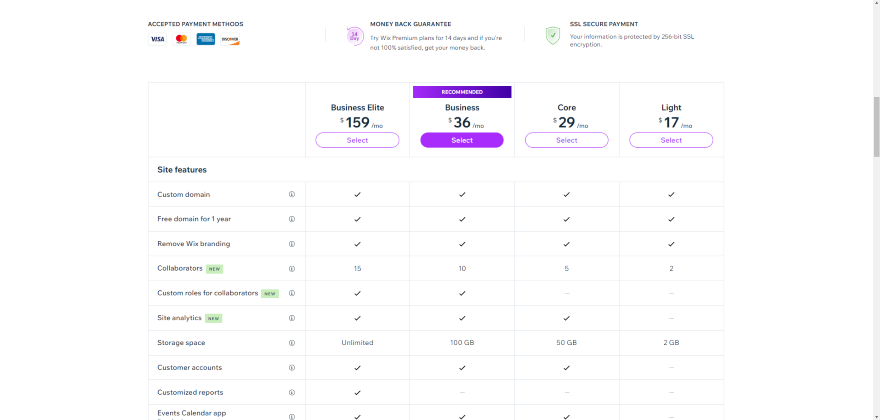
4. Choose a Business Website Template
It takes only 50 milliseconds for visitors to form an opinion on your website. If your design is messy or littered with pop-ups, people are more likely to leave. Fortunately, most website builders come with numerous templates to choose from that are both practical and stylish.
As soon as a visitor enters your website, your business branding should be as clear as day. Make sure that your unique tone of voice, font style, color schemes, and imagery are consistent across your website.
To show you just what you could achieve, below are some examples of eye-catching business website designs from Wix and Shopify users, and why they work so well:

- Brand: Floof Cotton Candy
- Website Builder: Shopify
- What I loved: I was immediately hit by Floof’s playful color scheme after opening their landing page, giving me a clear impression of what they sell. The varying shades of pink not only pack a punch, but also allude to the brand’s pastel-colored cotton candy cake.
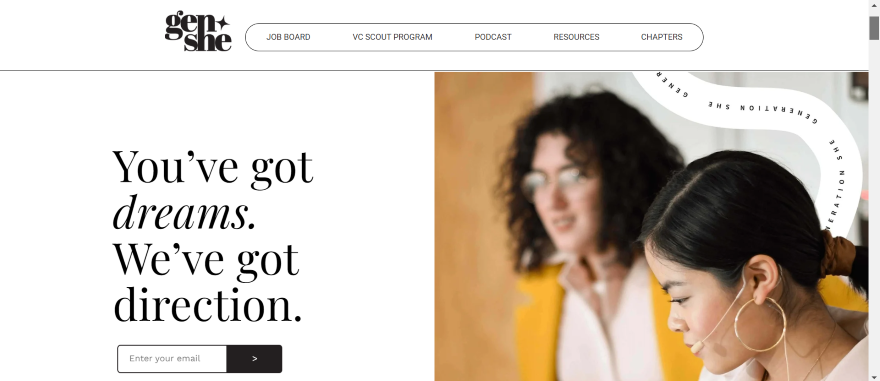
- Brand: Generation She
- Website Builder: Wix
- What I loved: Generation She, a business connecting Gen Z women with tech roles, is an inspiring website to navigate. I was immediately drawn to the empowering tagline and bold imagery that made me want to find out more about what the business stands for and how it works. As you scroll down the homepage, you’ll also come across photos of women business owners and a link to their podcast – all very clickable!
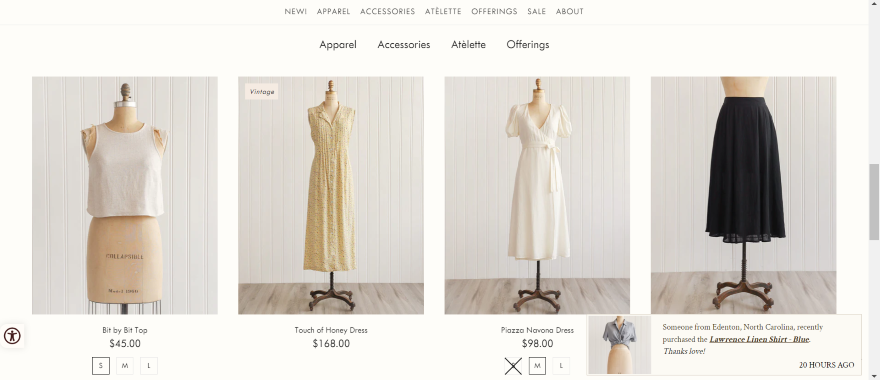
- Brand: Adored Vintage
- Website Builder: Shopify
- What I loved: This vintage clothing website pairs a muted color scheme with minimalist fonts and rich imagery to achieve an old-timey feel. I liked that I could dive straight into their clothing catalog from the homepage, while the professional photos grabbed my attention and inspired me to keep looking for the perfect dress.

- Brand: Dopple Press
- Website Builder: Wix
- What I loved: This photographic printing studio has a clear brand identity. I was immediately drawn to the quirky illustrations and playful fonts, which gave me a positive first impression of the business. Though the website’s design is unconventional, it didn’t affect the page’s functionality since I could still navigate the landing page without any issues.
Need more design ideas? Head to our how to design a website page!
Business Template Features To Look For
It’s not all about looks. Your template should also be equipped with key features that will enhance the user experience:
- Contact forms – These make it easy for prospects to get in touch with you. You could add a form to your landing page, “Contact Us” page, or both.
- Testimonials – Customer reviews add social proof to your website. You could feature testimonials from previous customers, or let website visitors add their own reviews. This is especially useful if you’re selling a product or service, since a positive review can be the difference between someone buying an item or leaving it in their cart.
- Call to action buttons – When a visitor browses your website, what’s the main thing you want them to do? Is it to sign up to your newsletter? Or purchase a product? Whatever it is, you can use eye-catching CTA buttons to inspire visitors to take the actions you want them to.
- Search bar – Visitors may come onto your business page to look for something specific, so you can give them a helping hand by adding a search bar to your website.
- Navigation bar – If you have multiple pages on your business website, you need to help visitors get from point A to point B. That’s where a navigation bar comes in handy. Whether you opt for a horizontal or dropdown navigation bar, it should enhance the user experience by keeping website navigation simple.

5. Fill Your Website With Relevant Content
Once you’ve set the foundation of your website – your template – you can start filling it with useful business content. This includes going through your website and replacing the placeholder content that the website builder has added with your own. But what needs to be included?
First of all, you may want to add different pages to your website. Here are a few ideas to get you started:
- “About Us” page – To build trust with potential customers, you need an “About Us” page. Use it to let visitors know more about your business, its goals, and most importantly, the person or team behind the brand. This is your chance to reach out to potential customers, so make sure your words count.
- “Contact Us” page – If a website visitor is inspired to reach out, they’ll no doubt head to your “Contact Us” page. On this page, you should include key ways for prospects to get in touch with you, such as your email address, physical address, phone number, external social media accounts, and even a contact form for specific enquiries.
- FAQ page – This page should be filled with valuable information for your audience, providing them with quick answers to commonly asked questions. When filling in this page, put yourself in the shoes of your target audience. What will they need guidance on?
- Products page – Opening an ecommerce site? If that’s a yes, then you need a dedicated products page. On this page, you could list featured products, or your entire inventory that users can filter via variants like “colors” or “sizes” or specific categories like “shoes” or “bags.”
- Services page – If you’re offering services, you’ll need a page listing exactly what you offer. For instance, a beauty salon owner may want to list the services they provide (french manicures, blow outs, etc) alongside a detailed description and prices. You could also install your bookings functionality on this page, letting visitors book their next appointment once they’ve scanned through each service.
- Bookings page – Whether you’re a beauty professional offering treatments or a financial expert offering consultations, a bookings page will be the hub for all things appointments. On this page, you can integrate your website builder’s booking tool to get started. Wix has a built-in booking tool that’s accessible on the Core plan and above, while Shopify’s app store has free and paid booking integrations to install on your website.
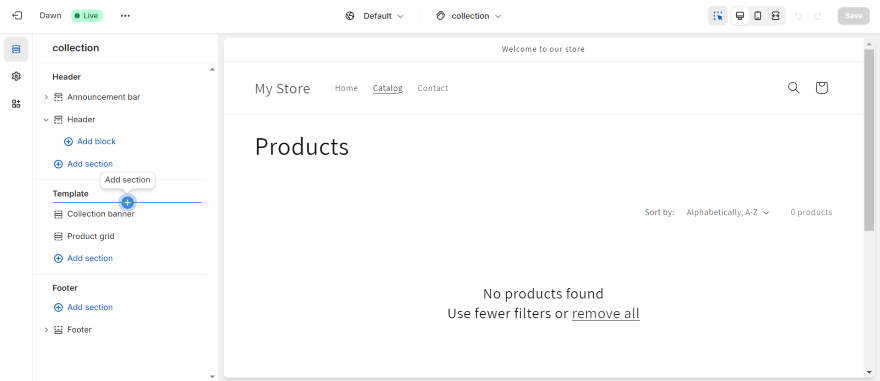
6. Integrate The Key Website Features You Need
When creating a business website, you also need to add additional functionality to your page. Some platforms, such as Shopify, come with an app market where you can install apps onto your website. They cover a variety of functionalities, ranging from social media integrations and testimonials to live chat bots or Google maps.
For instance, there are thousands of Shopify apps to choose from. When setting up my test store, I could use filters to browse through Shopify’s selection and find appropriate apps for my store. Though many apps required payments to use, some came with free trials and free plans. Because of these varying prices, you can find apps that fulfill your business’ needs and are still suitable for your budget.
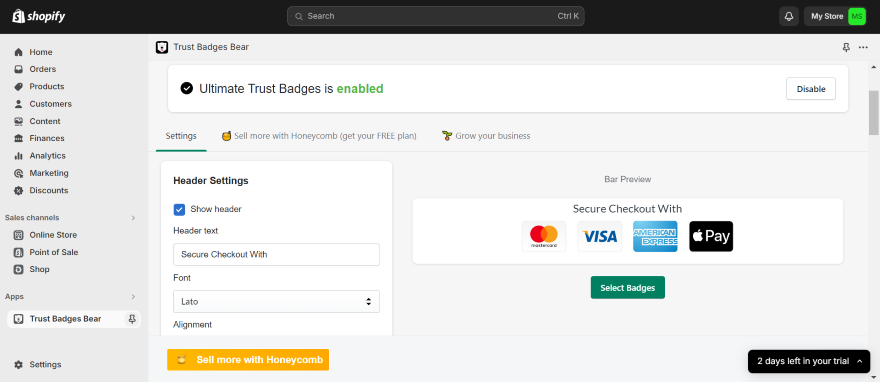
On the other hand, website builders can also come with a large number of built-in features. Wix is a brilliant example of this. Though Wix has its own app store, it also offers numerous in-built tools your business can take advantage of. Here are three that could be useful for your business:
- Wix Hotels – Announced in Wix’s April Review, this hospitality solution lets hotel businesses easily manage their services in one place. You can accept reservations and payments, manage rooms, and connect your business with websites like Booking.com.
- Wix Restaurants – In the restaurant industry? If so, you can use Wix Restaurants to create an appropriate website for your business. This feature comes with professional menus to showcase your dishes and beverages, and the ability to take and manage orders online.
- Wix Bookings – Be it group sessions, classes, or intro calls, you can use Wix Bookings to set up appointments through your business website. You can also accept payments from clients, send out email or SMS reminders to attendees, and update your schedule via your booking calendar.
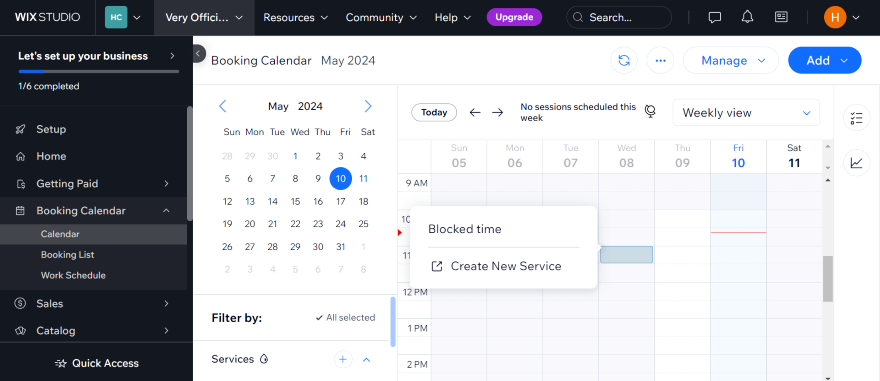
What About Marketing Features?
When looking at website features, I encourage you to check out marketing tools too. From email marketing to social media integration, these tools will help you grow your online presence and introduce your business to new audiences online. These are the key marketing features to look out for:
1. Social media marketing – Since platforms like TikTok, Facebook, and Instagram are home to over one billion monthly active users, you need to grow your business on social media too and tap into this huge user base.
Both Wix and Shopify make it easy to connect your business website with social media. For instance, Wix lets you create and share content on other social platforms like Facebook, and add links to your social media platforms on your website through social bars. These social bars feature social media icons that link out to your other pages.
Meanwhile, Shopify is well known for its multichannel selling opportunities. You can connect your store with TikTok and sell your products there, or access its Starter plan – priced at $5 per month (billed annually) – and sell on social media accounts without the need for a storefront.
2. Email marketing – According to our email marketing stats, 99% of users check their inboxes every day! Make sure your business appears in your customers’ inboxes by investing in email marketing. Both Shopify and Wix come with powerful email marketing tools.To get you started, you’ll find a variety of templates and customization options that help you create emails designed to impress.
Depending on your business, you could send out company updates, product updates, news on special events or webinars, special discounts codes, or intel on industry-related news stories.
3. Search engine optimization – an effective SEO strategy will ensure that your business website is visible on search engines.
When a user searches up a keyword or query that’s related to your business, you’ll want your website to appear in the search results. For example, if you’re a pet grooming business, you could target the keywords “pet groomer” or “mobile pet grooming” and see if you appear in Google.
If you’re new to SEO, there are free online tools that can help. For instance, I recommend downloading Keyword Surfer, a free Chrome extension that will assist you in finding the right keywords to target. It not only shows you relevant keywords for a search, but it also shows you how many times each keyword is searched for every month.
Need an intro to SEO? Consult our SEO basics article.
7. Optimize, Test, and Publish Your Website
You may be dying to publish your business website, but there are still two crucial things to do before going live: optimizing and testing out your website. The former step will ensure your business page is set up for search engines, while the latter will guarantee that your website works and provides visitors with a positive user experience.
Thankfully, these key steps aren’t as intimidating as you might think. When it comes to optimization, I recommend spending some time adding your chosen keywords into your website copy, making sure your website load times are speedy, and seeing if your page is mobile-friendly. All of these factors influence your website’s ranking on search engines, so make sure it’s all running smoothly.
Once you’ve optimized your site, you can then conduct your final tests. You need to test your website thoroughly and ensure that there are no glaring errors. As a starting point, look out for these common issues:
- Broken links – Ensure that your website links work, especially if you have important call to action buttons placed throughout your page. For instance, you wouldn’t want to miss out on a sale because a customer clicked on a “Buy Now” button that led to a “404 Error” page.
- Missing images – No one wants to see blank spaces where a vibrant image should have been. Go through each page of your website and make sure that all of your photos load fully. If they don’t, you may need to double check the media’s origin or optimize your photos to a lower file size.
Completed all of these checks? If that’s the case, go ahead and publish your website – congratulations!
How We Tested Business Website Builders
The findings in this article are supported by our in-house website builder research, which compiles over 200 hours of data collection. These findings were categorized into six key criteria, reflecting what users need most in a website builder. They are weighted as follows:
- Website Features (30%)
- Design Functionality (25%)
- User Experience (17%)
- Help & Support (10%)
- Value for Money (10%)
- Customer Score (8%)
We took these key criteria into account when choosing which website builders to feature in this article. For instance, website features are most important for readers, so we made sure to include a website builder with the best features on the market: Wix.
How To Build a Business Website: Summary
Well done for making it this far! You now know how to approach the process of creating a business website in seven easy steps.
Remember, the work doesn’t stop once you’ve published your website. You need to keep monitoring all aspects of your page, from site visitors to SEO performance, and make sure your website is succeeding online. To do so, I recommend connecting your website with Google Analytics, because it comes with advanced tracking tools that can tell you more about your website visitors and their behavior.
Keen to discover other website builders on the market? Get stuck into our guide to the best website builders and find the right fit for your business website today.
